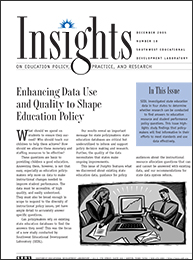Data System Reform: What Can Be Done
Policymakers, state data managers, and researchers need to work together to expand the use and quality of state education data to learn more about instructional resource allocation and its impact on student performance.
Specifically, policymakers and researchers should become more familiar with state data and regularly discuss, with SEA data managers, how the data could be improved to better answer policy questions. This would allow SEAs to expand the use of their data beyond traditional reports and monitoring purposes. Also, states should increasingly work with national data centers, such as the National Center for Education Statistics, to further establish and adopt national data standards that would enhance commonalities across states for a more complete picture of instructional resource allocation.
Some targeted improvements we recommend SEAs and other education policymakers consider are below:
- Add school-level detail for instructional expenditures.
- Institute more accurate ways to get teacher years of experience data.
- Ensure teacher certification data can be easily aligned to teachers’ subject areas and grade levels.
- Create databases that link individual teachers to their students and classrooms.
- Enhance collection of data on the costs, content, and quality of professional development.
Our research also highlighted varying SEA data accessibility issues across the states. As a result we recommend SEAs consider the following:
- Combine separate databases in a centralized data warehouse housed and managed by one department.
- Establish clear procedures for data requests, including the time and cost to provide the data.
- Find ways to share individual-level data while maintaining confidentiality.
- Have ample and knowledgeable staff in place to assist data users.
- Provide documentation explaining details of the data, i.e., definitions, calculations, and year-to-year changes. Post this documentation on agency Web sites.
We recognize that SEA data are collected for competing needs, such as federal reporting, tracking state accountability goals, and supporting state funding formulas. Consequently, reforming state education data systems takes careful planning and collaboration between those who manage the data and those who use the data. Critical to this process is for SEAs to balance the time and resource burdens that changes to their data systems create for schools, districts, and their own agency staff. Continued work remains to be done to ensure high-quality, user-friendly data are accessible that can be used to answer important policy questions about education resources and student achievement. Such efforts would support the creation of more reliable information needed for more effective decision making on the resources needed to help children succeed.
Next Page: What Can the SEA Data Tell Us?

